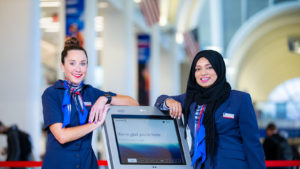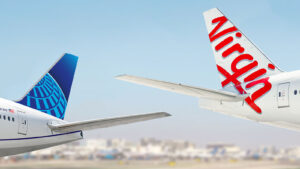Flying within the United States isn’t without its battles. But fortunately, the elite status you hold with an Australian airline could see you swanning your way into the fast lane or even into the lounge. You might also be able to avoid things like checked baggage fees. And for the most part, these perks apply with American Airlines and United Airlines.
American Airlines (AA) is Qantas’ biggest partner in the US – ditto United, for Virgin Australia Velocity. In this article, we’ll look at how the benefits of Qantas status on AA stack up against the perks of Velocity status on United. After all, with all of the status match offers that have been floating around, many frequent travellers will hold rank with both.
Certainly, Qantas and Velocity have other partners in North America too. In addition to American, Qantas has a fellow oneworld Alliance member in Alaska Airlines, plus a separate partnership with Canada’s WestJet. Over at Velocity, Hawaiian Airlines is also on board – as is Air Canada. But today, we’re zoning in on the two key partnerships across the Pacific. That’s AA for Qantas, and United for Velocity.
When it comes to benefits, we’ll be comparing like-for-like. How the treatment of a Qantas Platinum member flying American Airlines differs from the journey of a Velocity Platinum member booked on United, for instance. This story also isn’t a mere comparison of benefits tables – I’ve taken to the skies across the US to test things out in both camps for real.
It goes without saying of course, but I’ll say it anyway. If you only have status with one Australian airline, you’re probably best just to book with that airline’s Stateside partner. For instance, book American if you only have an elite Qantas card. And if you don’t have status at all, this article won’t be relevant to you. But for those who proudly sport a shiny baggage tag, here’s how the Qantas/American Airlines experience stacks up against Velocity/United.
Seat selection: American Airlines vs United
Before it’s time to fly, just about every self-respecting frequent flyer chooses their preferred seat. So how does that look on AA and United? For this, things get complicated given the presence of ‘Basic Economy’ on both airlines. This is essentially a fare type designed to compete with low-cost carriers (similar to ‘Lite’ fares on Virgin Australia itself). So for simplicity’s sake, we’ll compare the experience of flying on a ‘normal’ booking (not Basic Economy).
On American Airlines, standard seat pre-selection is free for all tiered Qantas Frequent Flyer members. On top of this, AA also allows ‘preferred’ Economy seats to be pre-booked by Qantas elites at no charge. These seats don’t have extra legroom or amenities – they’re just in more enviable locations, like closer to the front of the aircraft.
Over at United, normal Economy seat selection is generally complimentary. But there’s a bit of a catch. United categorises a significant chunk of its Economy cabins as being ‘preferred’ seats. Much like American, these seats are exactly the same as the rest of Economy: just closer to the front. For Velocity elites, choosing one of these seats attracts a charge. It’s quite common – especially for short notice bookings – to find only middle seats selectable for free, with the only aisles and windows available being in a chargeable ‘preferred’ section.
For Velocity members, the only way to grab a ‘preferred’ seat on United without paying a fee is to change seats once online check-in opens or after you’ve checked in.
Winner: We’re giving this one to American Airlines, given Qantas members can grab a free preferred seat from the time of booking.
Priority check-in: how AA compares to United
When it’s time to travel, what does the airport queue look like?
If you’re flying American Airlines, the priority lane welcomes those with Qantas Silver status and above. For flyers with Qantas Platinum (or higher), a separate Flagship Check-in facility is also available in key airports. In the US, that’s Chicago O’Hare, Los Angeles and Miami (plus London, across the pond).
Over at United, the ‘Premier Access’ priority check-in lane is available to Velocity Gold members and above. Unfortunately, Velocity Silver members need to join the back of the regular Economy queue. There’s also nothing faster for Velocity Platinum or Virgin Australia Beyond members, who can’t use the separate facilities reserved for Polaris (Business Class), United 1K and Global Services.
Winner: For Gold frequent flyers, things are effectively equal. But given American Airlines extends the perk to Qantas Silver members and has something better for Qantas Platinum at key airports, American wins on overall balance.
Checked baggage for elite flyers: AA vs United
When flying Economy within the US, it’s standard that no checked baggage is included for free. But this is another instance when frequent flyer status is your friend – and that’s true of both American Airlines and United.
Here’s a look at the free baggage allowances available on these two carriers based on Australian frequent flyer status.
| Free checked baggage by status | Silver members | Gold members | Platinum members |
| American Airlines | 1x23kg (Qantas Silver) | 2x23kg (Qantas Gold) | 3x32kg (Qantas Platinum and above) |
| United Airlines | No free allowance (Velocity Silver) | 1x23kg (Velocity Gold) | 1x23kg (Velocity Platinum and above) |
This is one of the ways in which the experience of flying American Airlines as a Qantas member strongly outperforms flying United as a Velocity member. In every category – Silver versus Silver, Gold versus Gold, Platinum versus Platinum – American Airlines is more generous.
It’s also notable that AA allows Qantas Platinum members (and above) to pack heavier bags too. This means being able to travel with up to 96kg of free checked baggage as Qantas Platinum on AA, versus 23kg of checked baggage as Velocity Platinum on United. By weight, AA’s allowance for Qantas Platinum flyers is more than four times as generous as on United with Velocity Platinum.
Winner: American Airlines, for the reasons above.
Priority security: American Airlines versus United
When it comes to taking the fast lane through security, it really depends on which airport you’re flying through. That’s true for both airlines, as not every airport – and every checkpoint – has a priority lane for elite frequent flyers.
Where available, American Airlines again sits on the more generous side, opening up these priority lanes to Qantas Silver and above. It’s a nice perk, given that in Australia, Qantas only offers the same privilege for Gold and above – not Silver. This really came in handy for me in Chicago, when departing right after Christmas on one of the airport’s busiest days.
United Airlines mirrors its priority check-in policies for priority security. This means Velocity Gold members (and above) qualify for Premier Access. That served me well in San Antonio at the end of a conference attended by 6,000 people – all leaving around the same time. But again, Velocity Silver members don’t get a fast-track.
For what it’s worth, I’ve also had no problems in bringing one companion through the priority lane in both instances. When flying from Chicago, my companion’s boarding pass also displayed ‘priority’ in large letters. That’s despite having no status of her own: but it appeared automatically because she was on the same booking as me. With United in San Antonio, a companion was on my flight but on a separate booking, yet we also had no issue.
Winner: I’m calling this one a draw. On the one hand, AA extends this perk to Qantas Silver members, whereas United doesn’t do the same with Velocity Silver. But by the same token, Velocity Gold and Platinum members might encounter comparatively shorter priority queues on United, given the tighter restrictions to use them.
Lounge access on US domestic flights
On domestic-only flights, the rules are a lot more generous for Qantas elites flying with American than Velocity members booked on United. And for that matter, AA even grants entry to those who pay for Qantas Club membership.
American Airlines has two types of lounges in the US. Here’s who qualifies:
- Flagship Lounge: Qantas Gold members (and above) prior to any American Airlines (or other oneworld) flight. This includes domestic-only tickets.
- Admirals Club: Qantas Club members prior to any American Airlines flight – including US domestic journeys.
By nature of the oneworld Alliance, Qantas Gold members (and above) may also be able to enter the lounges of other partner airlines when flying with AA. And in Los Angeles, Qantas Platinum members can visit the Qantas International First Lounge before a domestic American Airlines flight, too.
United Airlines also has two types of lounges in the US. Here’s how that works for Velocity members:
- Polaris Lounge: Entry not permitted to Velocity members of any tier. (Instead, you must be flying long-haul Business Class or First Class).
- United Club: Access for Velocity Gold (and above), but technically, only as part of an international itinerary with United Airlines – not a domestic-only hop. No access for paid Virgin Australia Lounge members.
With Velocity status on United, it never hurts to ask at the lounge reception. Sometimes, it just works – even when it technically shouldn’t. Like for me when flying from San Antonio, ahem. (I may have even booked United from San Antonio knowing it was the only airline with a lounge there, hoping that would happen, cough cough).
Winner: Given American Airlines openly welcomes Qantas members into its lounges for US domestic travel, this is a clear win for AA overall. Neither airline has a lounge in every airport though, so don’t forget to check.
If you’re in a pickle, don’t forget about alternatives too, such as the American Express Centurion Lounge network.
Priority boarding on US domestic flights
It’s finally time to fly – so who gets on the plane first? Both American Airlines and United Airlines board flights by groups. For elite travellers, AA takes a staged approach, while United welcomes most tiered members at the same time.
Here’s how things work on American Airlines:
- Group 2: Qantas Platinum, Platinum One and Chairman’s Lounge.
- Group 3: Qantas Gold.
- Group 4: Qantas Silver.
United, on the other hand, simply puts Velocity Gold members (and above) into Group 1. But again, with no recognition for Velocity Silver. Sadly, not even with a bump to Group 2 – in which United categorises its own Silver-grade members.
In essence, Qantas Silver members on American and Velocity Gold members on United get to board before others in Economy. And so do those at the higher ranks. AA’s approach of dividing elite members by tier also provides greater recognition for those who travel more than most while extending the privilege to Silver members too. On the other hand, United’s approach of boarding high flyers all in Group 1 does help to reduce jostling at the gate.
Winner: It’s fair to say this one is a draw – although Silver members are better off on American. When flying AA and United as Gold and Platinum, I’ve never failed to get a cabin bag into the overhead lockers. This is true even when boarding AA in Group 3 on busy flights: there’s still plenty of bin space.
Summing up
On paper, it’s fair to say that the tie-up between Qantas and American Airlines has its strengths over the Velocity/United partnership. That’s to be expected, of course, given that Qantas and AA aren’t merely members of the oneworld Alliance. The two carriers co-founded oneworld back in 1999 – alongside British Airways, Cathay Pacific, and the now-defunct Canadian Airlines.
Accordingly, AA treats Qantas elites very well, on account of their oneworld status. For that matter, AA goes far beyond the oneworld ‘minimum standards’ governing what one airline must do for another partner’s members. For instance, opening priority security and boarding to Qantas Silver members, despite ‘only’ being oneworld Ruby members.
As for Velocity and United, it’s a bespoke arrangement between the two airlines. But because Virgin Australia isn’t a Star Alliance member, some benefits aren’t as strong as United provides for its Star Alliance counterparts. Everything is reciprocal – United does for Velocity members what Virgin Australia does for United’s own MileagePlus flyers.
This explains why there’s no priority check-in or recognition for Velocity Silver members on United. Although Virgin Australia has some short-haul international routes, the bulk of its network is domestic. And on domestic flights, Virgin doesn’t allow any Silver members to use priority check-in. This includes United Premier Silver. In turn, United doesn’t extend this privilege when Velocity Silver members fly Stateside.
But it’s fair to say that if you have Velocity status – and Velocity status alone – things are decent enough that you’re probably going to book with United anyway. It may not be perfect, but for many, it’ll be good enough. And certainly, still better than flying another US airline without the benefits of status. For loyal Velocity elites, it gets the job done.
For those fortunate to have status with both Qantas and Velocity though, the world is your oyster. And for that matter, you’d also have more freedom to book based on other factors too – such as price and schedule – without forgoing the creature comforts you’ve come to expect.
Also read: What it’s like to fly United as a Velocity member
Feature image courtesy of Andrea Piacquadio/Pexels.
Stay up to date with the latest news, reviews and guides by subscribing to Point Hacks’ email newsletter.






Thanks for the awesome article. Bit of a dilemma for me and hoping you could help.
I am due to travel to the US in June. Yet to book a domestic leg ( NY – SFO).
My return flight from US is booked with United on Polaris Business from SFO into BNE.
I am Virgin Plat, Star Alliance Gold & One World Saphhire(Due to expire in March).
Which airline should I consider booking my domestic leg purely on the basis of check in baggage allowance.
If I book United domestic will they be able to link my domestic ticket with my International return ticket and would that then allow me to carry more than 1 checked baggage without paying a fee? Also note that my return flight from SFO to BNE is not until the next day.
OR should I book with AA as I am One World Sapphire which allows me to take 2 Checked in bags without a fee but I wont be One World Sapphire at the time of flying, only at the time of booking.
The Checked bag fee sounds ridiculous and would like to avoid it if I can.
I’m working towards Gold this year because business class seats (First in the US) are so much cheaper for the distance and proportional costs to economy seats here. For a price difference of sometimes as little as $80-100 USD you can rack up 40 status credits instead of 10 on a short trip.
I won’t fall over backwards praising any US airline domestically, but, I will give AA their due.
On the ground, they’re fantastic to QFF people. They’ve helped me on many occasions.
Cheers!
(A mistake I made once and thankfully wasn’t charged due to kind agent.)
https://www.americanairlines.com.au/i18n/travel-info/baggage/checked-baggage-policy.jsp
To reiterate the reply previously posted, on US domestic flights, AA grants one checked bag for Ruby (Qantas Silver), two checked bags for Sapphire (Qantas Gold), and three checked bags for Emerald (Qantas Platinum and above). This is documented here, on AA’s website. This page notes that the standard limit for complimentary bags is generally 23kg.
However, when you further peruse the charges for overweight bags, AA confirms that Emerald frequent flyers can instead pack up to 32kg per checked bag, versus the usual 23kg. The policy reads, “Flagship® First and Flagship® Business Plus confirmed customers and AAdvantage Executive Platinum®, AAdvantage Platinum Pro® and oneworld® Emerald members can check 3 bags up to 70 lbs / 32 kgs at no extra cost.”
This means the total allowance on AA (on a US domestic flight, on an AA ticket) is 1x23kg for Qantas Silver, 2x23kg for Qantas Gold, but 3x32kg for Qantas Platinum and higher. AA chooses to be more generous with these allowances than the ‘minimum standards’ of the oneworld Alliance more broadly. But for those with oneworld status, it does make booking with AA quite a compelling choice.
We’ve examined these policies in more detail in this article: How to avoid checked baggage fees on US domestic flights.
Also, Chris, if I’m flying business class on WestJet metal under a Delta ticket, can I add my Qantas number?
The check-in kiosk didn’t recognise the additional free bag and the agent wasn’t willing to investigate or help.
After the flight I complained to United via their web form: customer care apologised but are refusing to refund the $100 USD bag fee, offering a flight credit instead.